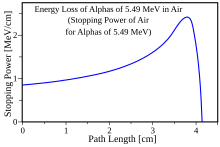
The Bragg peak is a pronounced peak on the Bragg curve which plots the energy loss of ionizing radiation during its travel through matter. For protons, α-rays, and other ion rays, the peak occurs immediately before the particles come to rest. It is named after William Henry Bragg, who discovered it in 1903.[1]
When a fast charged particle moves through matter, it ionizes atoms of the material and deposits a dose along its path. A peak occurs because the interaction cross section increases as the charged particle's energy decreases. Energy lost by charged particles is inversely proportional to the square of their velocity, which explains the peak occurring just before the particle comes to a complete stop.[2] In the upper figure, it is the peak for alpha particles of 5.49 MeV moving through air. In the lower figure, it is the narrow peak of the "native" proton beam curve which is produced by a particle accelerator of 250 MeV. The figure also shows the absorption of a beam of energetic photons (X-rays) which is entirely different in nature; the curve is mainly exponential.

This characteristic of proton beams was first recommended for use in cancer therapy by Robert R. Wilson in his 1946 article, Radiological Use of Fast Protons.[3] Wilson studied how the depth of proton beam penetration could be controlled by the energy of the protons. This phenomenon is exploited in particle therapy of cancer, specifically in proton therapy, to concentrate the effect of light ion beams on the tumor being treated while minimizing the effect on the surrounding healthy tissue.[4]
The blue curve in the figure ("modified proton beam") shows how the originally monoenergetic proton beam with the sharp peak is widened by increasing the range of energies, so that a larger tumor volume can be treated. The plateau created by modifying the proton beam is referred to as the spread out Bragg Peak, or SOBP, which allows the treatment to conform to not only larger tumors, but to more specific 3D shapes.[5] This can be achieved by using variable thickness attenuators like spinning wedges.[6] Momentum cooling in cyclotron-based proton therapy facilities enables a sharper distal fall-off of the Bragg peak and the attainment of high dose rates. [7]
YouTube Encyclopedic
-
1/3Views:102 510407 2603 646
-
How does proton radiation therapy work?
-
How does Proton Therapy work?
-
NUCLEAR PHYSICS | Lecture 7 | Bragg's Curve
Transcription
See also
References
- ^ Charlie Ma, C-M; Lomax, Tony (2012). Proton and carbon ion therapy. Boca Raton: CRC Press. p. 4. ISBN 9781439816073.
- ^ "Bragg Curves and Peaks". Brookhaven National Laboratory. Retrieved 27 January 2016.
- ^ Wilson, Robert R. (1946-11-01). "Radiological Use of Fast Protons". Radiology. 47 (5): 487–491. doi:10.1148/47.5.487. ISSN 0033-8419. PMID 20274616.
- ^ Trikalinos, TA; et al. (2009). Particle Beam Radiation Therapies for Cancer [Internet]. Comparative Effectiveness Technical Briefs, No. 1. Rockville (MD): Agency for Healthcare Research and Quality (US). pp. ES1–ES5.
- ^ Jette, D.; Chen, W. (2011). "Creating a spread-out Bragg peak in proton beams". Physics in Medicine and Biology. 56 (11): N131-8. doi:10.1088/0031-9155/56/11/N01. PMID 21558588. S2CID 37517481.
- ^ Paganetti, Harald; Bortfeld, Thomas. "Proton Beam Radiotherapy - The State of the Art1" (PDF). AAPM. p. 16. Retrieved 27 January 2016.
- ^ Maradia, V., Meer, D., Dölling, R. et al. Demonstration of momentum cooling to enhance the potential of cancer treatment with proton therapy. Nat. Phys. (2023). https://doi.org/10.1038/s41567-023-02115-2.
External links
- Wagenaar, Douglas (1995). "7.1.3 The Bragg Curve". Radiation Physics Principles. Archived from the original on 1 March 2016. Retrieved 27 January 2016.
- "Bragg peak". Oxford Reference. Oxford University Press. Retrieved 27 January 2016.
- Hojo, Hidehiro (3 July 2017). "Difference in the relative biological effectiveness and DNA damage repair processes in response to proton beam therapy according to the positions of the spread out Bragg peak". Radiation Oncology. 12 (1): 111. doi:10.1186/s13014-017-0849-1. PMC 5494883. PMID 28673358.
- Endo, Masahiro (20 October 2017). "Robert R. Wilson (1914–2000): the first scientist to propose particle therapy—use of particle beam for cancer treatment". Radiological Physics and Technology. 11 (1): 1–6. doi:10.1007/s12194-017-0428-z. PMID 29058267. S2CID 3526846.
- Grun, Rebecca (10 January 2017). "Systematics of relative biological effectiveness measurements for proton radiation along the spread out Bragg peak: experimental validation of the local effect model". Physics in Medicine and Biology. 62 (3): 890–908. doi:10.1088/1361-6560/62/3/890. PMID 28072575. S2CID 24855475. Retrieved 19 March 2021.
